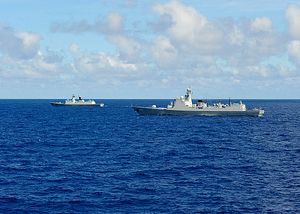How is the Chinese People’s Liberation Army handling conflict between its constituent services? And how have those services decided to compete with one another? A recent report by Ian Burns McCaslin and Andrew Erickson for the China Aerospace Studies Institute examined the prospect of interservice competition over the maritime domain among China’s military services.
McCaslin and Erickson argue that the service components of the PLA have, as of late, sought more resources and greater autonomy by arguing that they can contribute to China’s security in the maritime domain. The PLAAF, in particular, has aggressively stepped up its training and preparation for maritime missions, including long flights over water and flights in the vicinity of Taiwan. The Su-35 and the H-6K have played especially prominent roles in this effort.
Services compete over missions because they desire more resources and greater autonomy. Historically, the nexus of the air and maritime domains has been a fertile source of conflict between navies and air forces. In the United States, the Navy and the newborn Air Force fought bitterly in the late 1940s over funding for aircraft carriers and strategic bombers. The Air Force won the conflict, in part by arguing that nuclear weapons had rendered aircraft carriers irredeemably obsolete. Eventually, of course, the United States acquired both. In the United Kingdom, a series of bitter disputes between the Royal Air Force and the Royal Navy hamstrung carrier aviation, and slowed development of land-based maritime aviation. Thus, the historical record suggests that competition is quite likely as air and naval services develop cross-domain capabilities.
Whether or not the PLAAF has a sense of the historical parallels, it most definitely has adopted an aggressive public relations strategy. As McCaslin and Erickson note, the PLAAF undertook efforts to shape China’s social media landscape before the other components of the PLA. It has used this presence to heavily publicize its activities, especially in the maritime domain. Indeed, the PLAAF has sometimes leveraged Taiwanese news reports about its activities to contribute to its reputation as an active service.
The PLAAF has also made forays into more traditional public engagement, such as film. The authors cite the awfully bad 2011 film Sky Fighters, a direct homage to Top Gun that highlighted the J-10 and J-11 fighters. A more competently made film, Sky Hunters, apparently showcased the PLAAF, although not specifically its maritime component. And while the PLAN has not engaged the PLAAF on the social media terrain, the well-made and extremely successful Operation Red Sea offered a strong case for the service. Again, this echoes how navies and air forces have competed with one another in the past; in the 1980s, for example, the U.S. Navy competed against the U.S. Air Force over the unenviable prospect of trying to make fighter pilots seem cool. The U.S. Navy managed to capture the public imagination with Top Gun, while the Air Force failed even to contribute to the mediocre “Iron Eagle” series. More recently, the Air Force has seen some success with the PR campaign surrounding Captain Marvel, which focuses on the contributions made by female aviators. Still, the focus on PR as a method of interservice competition is interesting in an authoritarian country with a regulated media ecosystem.
Interservice competition is not always bad; it can drive services to develop new missions and enhance their warfighting capabilities. If competition over resources does not bleed over into conflict over missions, the PLAAF and PLAN can hope for a future in which they rely on each other to complete critical requirements. But competition can also go wrong, making communication difficult and opening up tactical and operational gaps. With little combat experience to its credit, it remains to be seen how the PLA will manage this problem.
The views expressed here are his personal views and do not necessarily reflect those of the Department of Defense, the U.S. Army, the Army War College, or any other department or agency of the U.S. government.

































